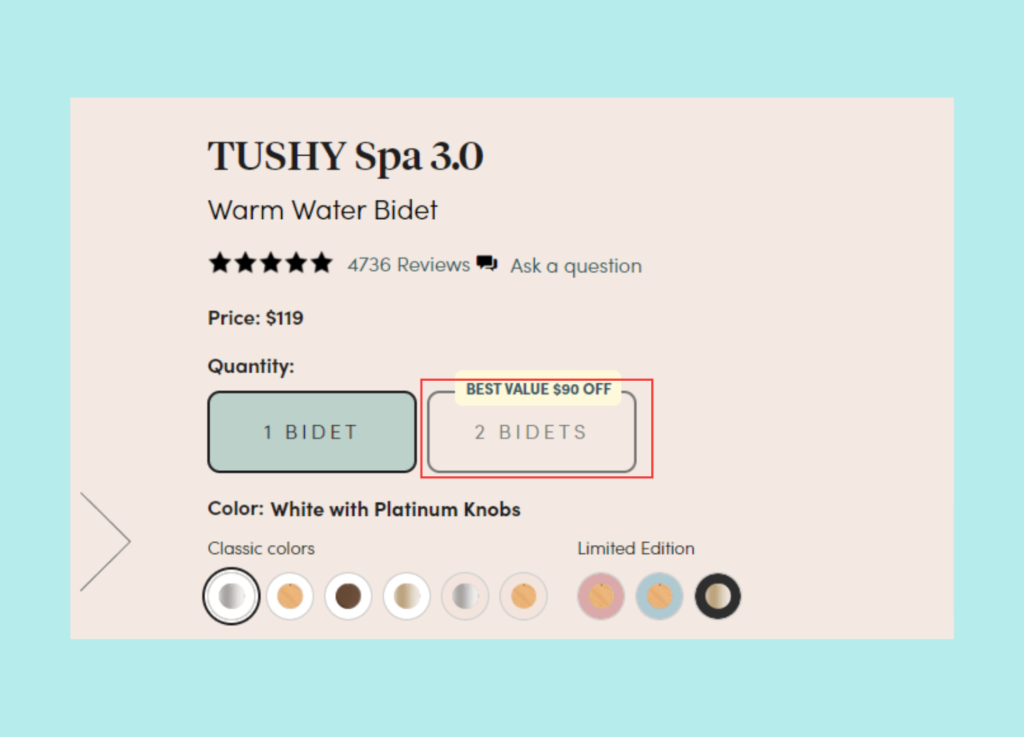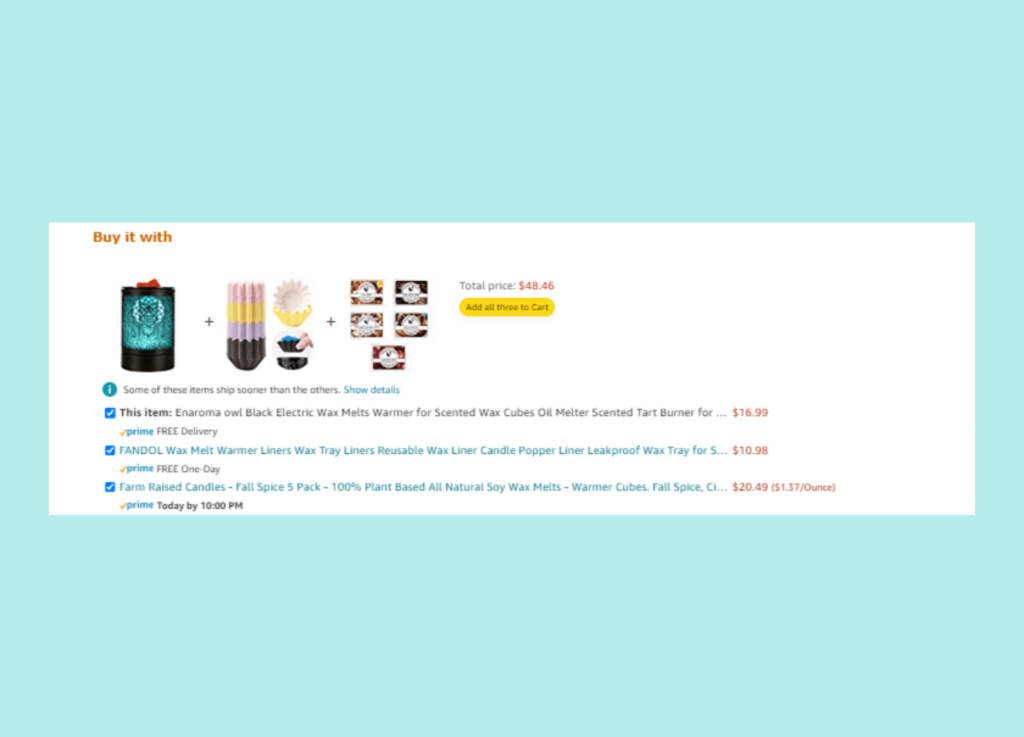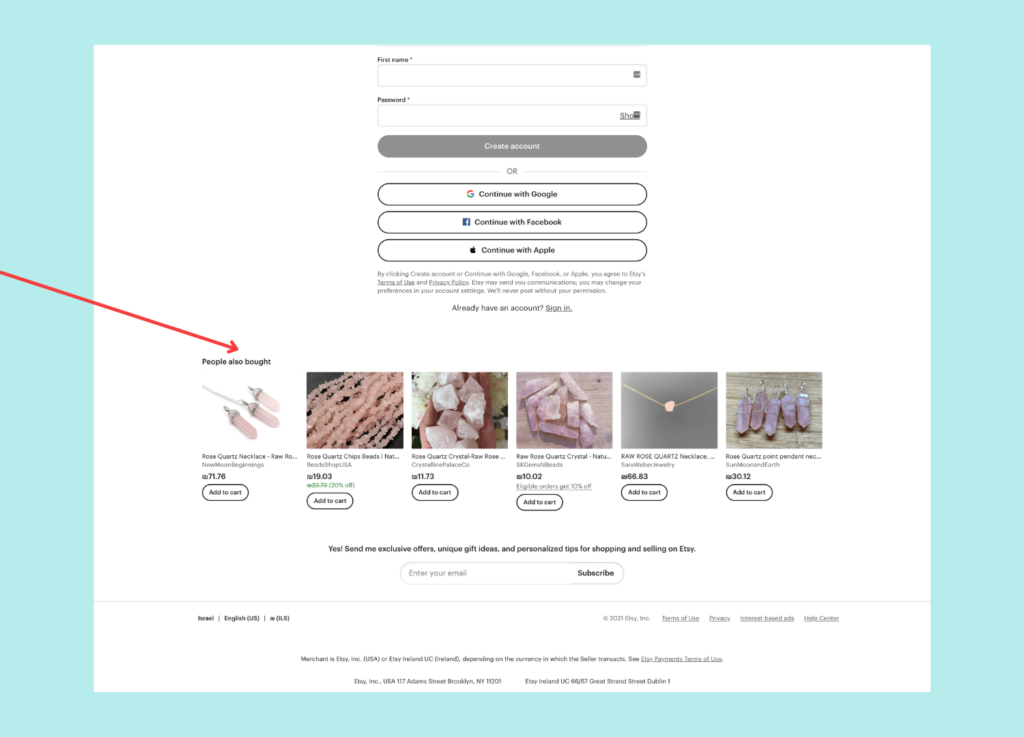Table of contents
Cross-selling tactics are some of the most valuable tools in any online merchant’s kit.
From small retailers to brands like Amazon and Nike, tons of stores use cross-selling strategies to increase revenue, and, for good reason.
But what exactly is cross-selling? And how can you use it to create a sales strategy that skyrockets your bottom line?
In this post, we’ll talk about all of that and more.
So without further ado, let’s get right into it.
What is Cross-Selling?
Cross-selling is a form of suggestive selling that’s similar to upselling or downselling.
In essence, it’s the act of offering complementary products when a customer makes a purchase.
The famous line from McDonald’s “Would you like fries with that?” is probably the most well-known example of cross-selling strategies, but there are plenty more.
Amazon makes use of cross-selling all over its website, with a “Frequently bought together” section and plenty of recommendations at every corner.
How Cross-Selling Strategies Increase a Store’s Average Order Value
The idea behind cross-selling is simple.
If you catch a customer while they’re already in “buying mode,” it’s much easier to sell a product that goes along with their original purchase.
For instance, if someone buys a brand new guitar, there’s a good chance they’ll be willing to add on a few picks and a pack of guitar strings.
This strategy is so effective that cross-sales make up a reported 35% of the purchases on Amazon alone.
Here are a few more reasons that cross-selling is a great strategy for any ecommerce store.
a) Smart Cross-Selling Improves the Customer Experience
Cross-selling is a great way to improve customer happiness if done correctly.
See, recommending smart products can help customers find things they might not have seen otherwise, from add-ons to brand new products altogether.
Helping customers find those recommendations is a win-win for both parties involved.
b) It can be Used to Promote New Products
One of the best ways you can promote a new store productis by offering it as an add-on to one of your best-selling products.
Using this tactic, you can give your fresh releases a bit of much-needed momentum right out of the gate.
c) It’s a Low-Risk Strategy
One of the biggest benefits of cross-selling is that it’s low-risk and low-investment.
Since you’re offering cross sales to people already in the purchase process, it doesn’t cost anything extra in terms of marketing.
And unless your offer is outlandishly expensive, even a rejected cross-sell won’t hurt the chances of conversion in most cases.
6 Cross-Selling Strategies to Take Your Business to the Next Level
Now that we’ve gotten the benefits out of the way, let’s talk about a few great strategies you can use to put it into practice.
1. Offer Discounted Sales Bundles to Customers
Bundling multiple products together is a great way to get more out of each sale.
For example, here’s how Tushy uses cross-selling to encourage customers to buy more:

You could buy one bidet for $100, or you can save $80 by purchasing two at once.
Not only is it a hard deal to resist from the consumer side, but it helps Tushy move more products off the shelves and make more from each order.
Even if Tushy may make a slightly lower margin off of the bundle product, the money they’ll save in marketing and packaging & shipping both products at once will more than make up for those costs.
2. Add Personalized Product Recommendations to Your Store
The next great way to implement cross-selling into your store is with personalized offers.
One great example for this is Amazon:

With every purchase, you’ll see a “Frequently bought together” section that gives a deal on the best products to go with your purchase.
This section is customized to fit each user’s purchase, which makes it all the more enticing to buy.
In your own store, you can emulate this tactic by using plugins or extensions to add product recommendations to your product pages.
3. Make Use of Threshold-based Sales Offers
Another great way to increase your store’s AOV?
Give customers an incentive to purchase more in each transaction.
Pairing cart thresholds with cross-sales strategies can be some of the most effective methods to earn more revenue.
Here’s how the sports clothing brand, Athleta, uses those tactics excellently:
Each shopping cart comes with a progress bar at the bottom that tracks order value.
Reach $50 with your order and you get free shipping, and conveniently, there’s a whole list of suggested products that go great together.
While threshold-based offers aren’t necessarily cross-selling strategies themselves, the two tactics go hand in hand.
In your store, you can use similar tactics by offering discounts or shipping deals if customers reach a certain order value. To further entice larger orders, make any easy-to-find related products section full of complementary products.
4. Integrate Post Purchase Cross-Selling in Your Store
Making offers in the post-purchase phase is a great tactic because there’s even less risk.
In a standard pre-purchase cross-sell, the risk is low, but you’re still running the chance of changing the customer’s mind in the first place – which leads to no purchase at all.
When it comes to post-purchase cross-selling, not only has each customer already made the decision, but they’re also in peak “buying mode.”
Brands like Amazon and Etsy use this tactic all the time to increase customer lifetime value, here’s an example that the latter uses:

5. Use Email to Boost Your Bottom Line
On-site isn’t the only place where you can make use of suggestive selling strategies.
Email marketing is another great avenue to start increase revenue, here’s how Forever 21 does just that:

When you make a purchase on their site, Forever 21 uses email campaigns to market complementary products right to your inbox.
It’s a similar strategy to abandoned cart campaigns too.
In your own store, you can use customers’ purchase history to market the products they’re most likely to buy right in their email inboxes.
6. Use In-Cart Add-ons to Introduce Small Add-Ons to Customers
eCommercecheckout can be similar to the checkout line in a traditional store.
In a checkout line, you’ll find tons of small add-ons, snacks, and drinks to encourage shoppers to make impulse purchases.
What you’ll almost never find in a checkout line are high-ticket items.
This is for a few reasons.
The in-cart experience is great for small cross-sells as they have the least risk of canceling the sale.
Selling high-ticket items as add-ons runs the risk of changing a customer’s mind altogether though.
Here’s how 4Ocean uses that strategy in their shopping cart:
Instead of huge add-ons, you can add a sticker or a donation to help them pick up more ocean waste.
It’s a great offer that doesn’t add much to the total price, and gives customers even more incentive through the ocean-cleanup incentive.
Tips to Start Cross-Selling & Convert More Customers
Before we close off, let’s go over a few general tips you can use to cross-sell more efficiently in your own store.
a) Don’t Oversell Before the Conversion
Cross-selling is great, but as we’ve mentioned before, if you try to oversell before a customer makes a purchase, you run the risk of ruining the sale altogether.
If you make offers pre-purchase, ensure they’re small offers rather than high-ticket ones.
b) Use Customer Data to Create Hyper-Targeted Offers
Using customer purchase data, you can find the most likely offers to convert.
There are plenty of extensions and add-ons on Shopify and Magneto that allow you to do just that.
Our recommendation?
Track the items that are most frequently bought together, and start offering them as bundle deals to increase your chances of converting.
c) Use an App or Extension to Integrate Cross-Selling into Your eCommerce Platform
Plenty of platforms come with their own drawbacks and limits, but extensions and apps can help you overcome those and increase your store’s customization options.
If you want to add some of the features we’ve covered in this post on Magneto, try SimiCart’s customization services to add more functionality to your store.
And if you’re using Shopify to power your store, ReConvert is a great way to add Amazon-style cross-sells and upsells to each funnel.
Wrapping Up: Use These Cross-Selling Strategies to Increase Profit From Existing Customers
Hopefully, this guide helps you convert more of your customers and increase AOV across the board.
If you found it helpful, make sure to check out more of the content on the SimiCart Blog!




